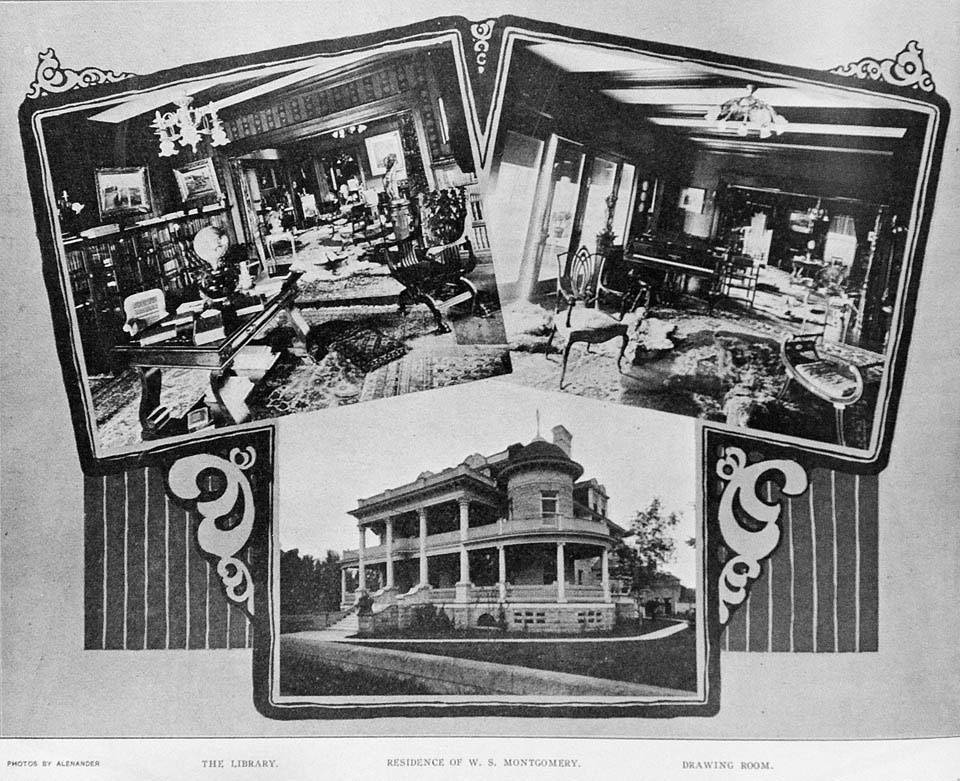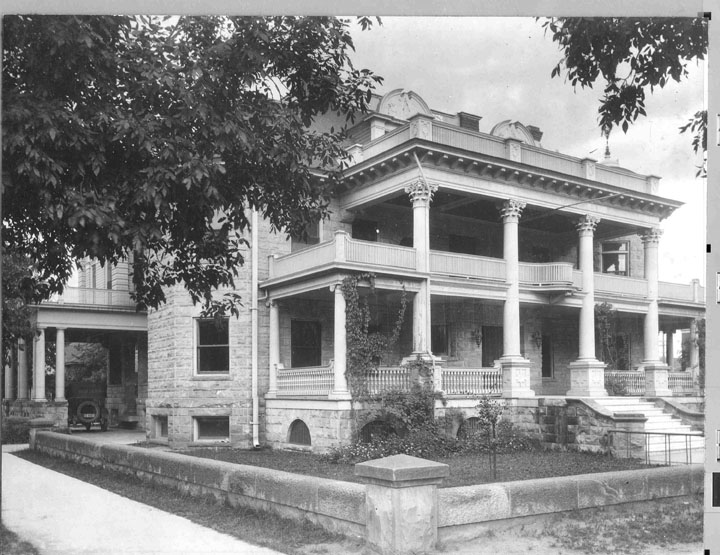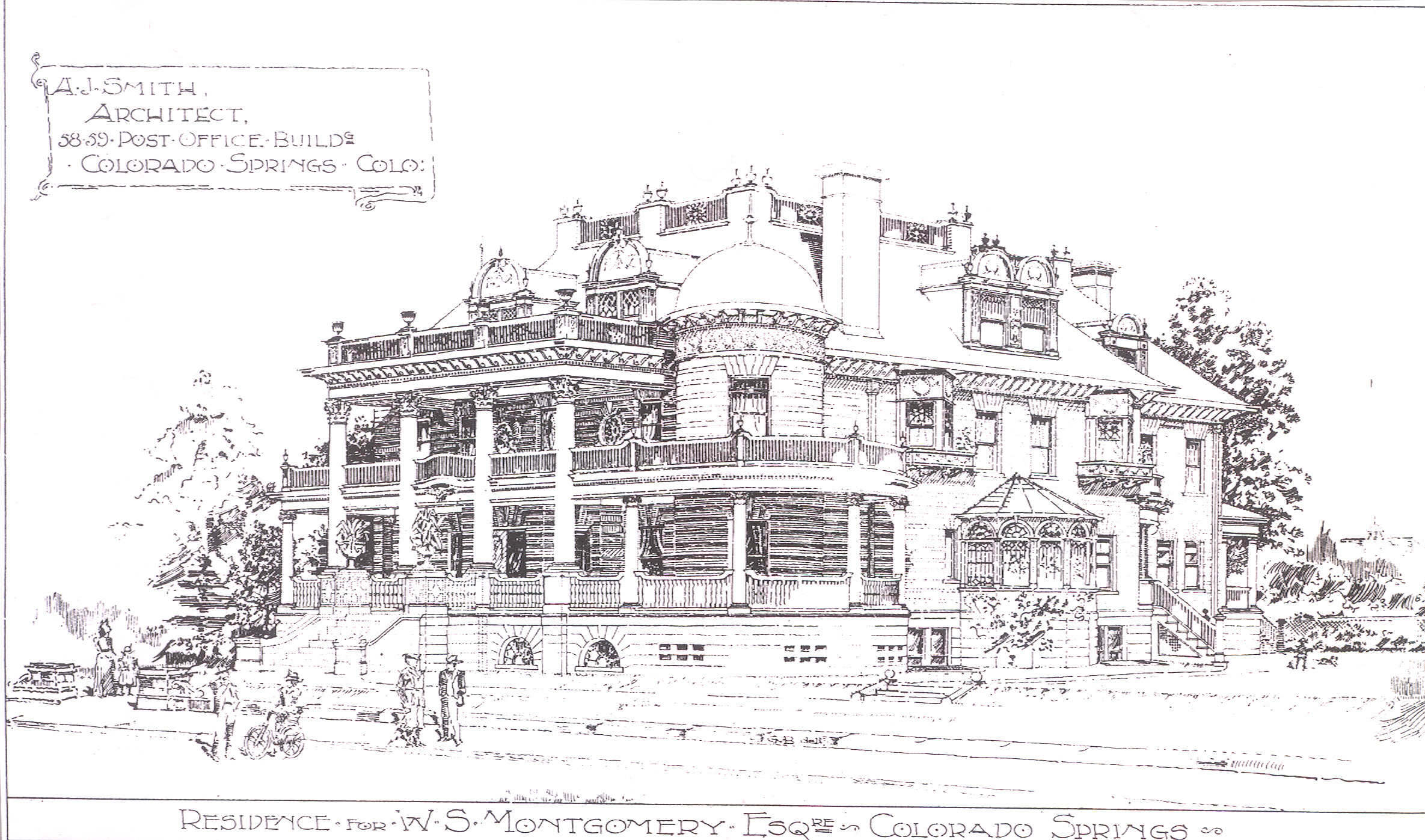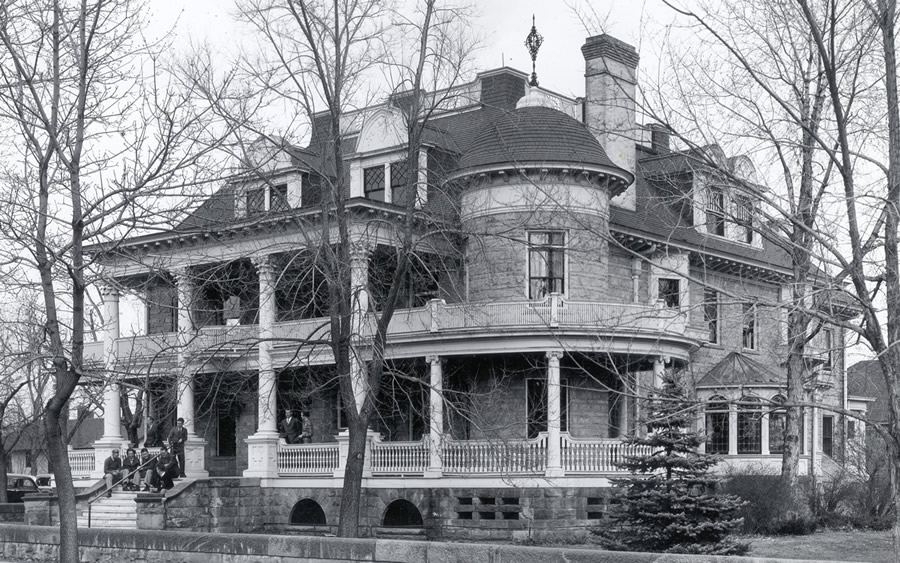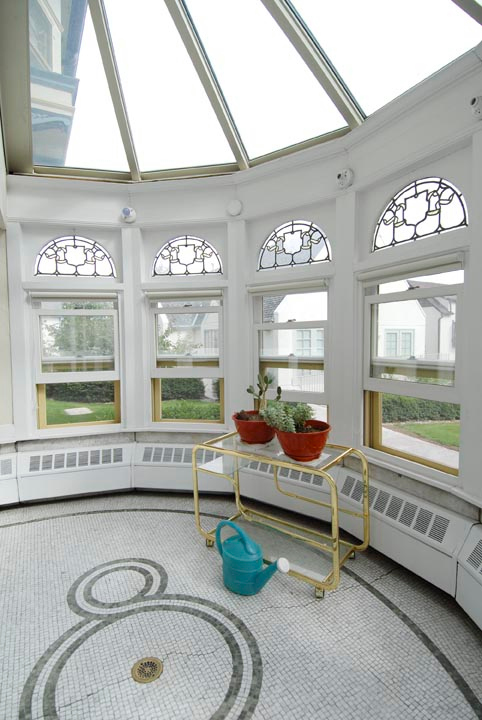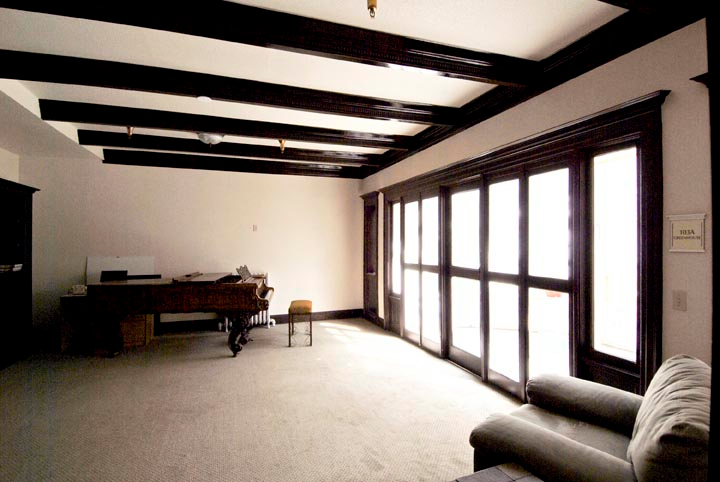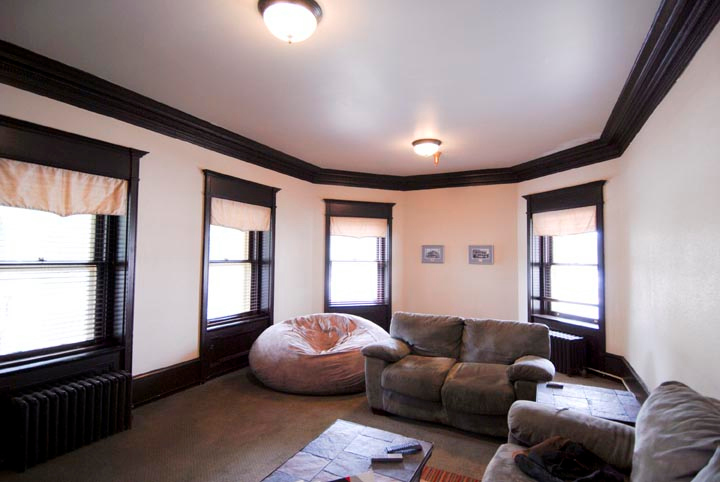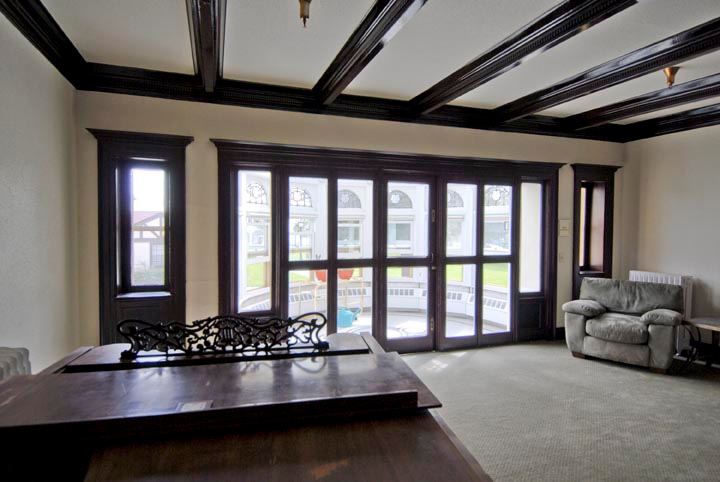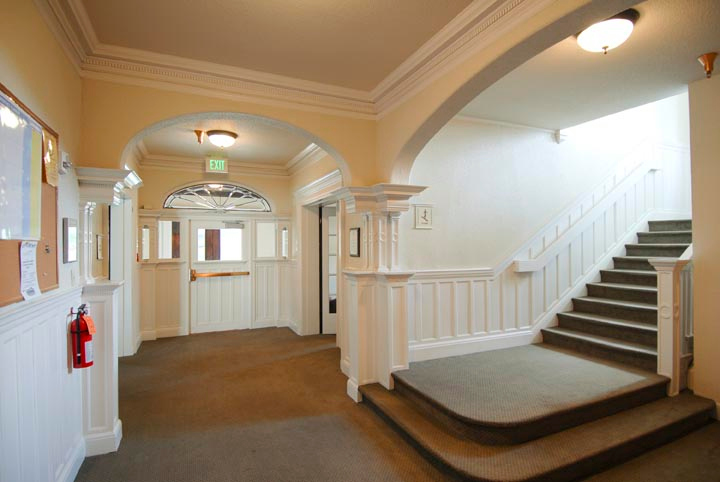Jackson House
Tour Stop: #10
Current Name: Jackson House
Historic Name: W.S. Montgomery House
Address: 1029 N. Nevada Avenue
Year Completed: 1900
Architectural Style: Colonial Revival
Architect: Augustus J. Smith, Colorado Springs
Designation: State Register
Access Level: Jackson House is a residence and therefore is not open to the public.
In 1900, Willis S. and Julia Montgomery completed this stone Colonial Revival style corner house facing Colorado College to the west. The improvement of the facilities and grounds of the college during the late 19th and early 20th centuries coincided with the growth and development of the city of Colorado Springs attendant to the discovery of gold at Cripple Creek. At the same time, the college added a number of substantial stone buildings to provide for its academic and residential programs. In addition, landscaping of the four-block college square was completed, providing an attractive view for the houses built adjacent to the campus.
W.S. Montgomery was one of a number of men who became millionaires as a result of investments in the Cripple Creek gold district. Born in Ohio, he studied law in his father's office and at Tabor College in Iowa. In 1879, Montgomery came to Colorado, establishing a law practice in the mining town of Silver Cliff. He and his father obtained an interest in the important Bull Domingo Mine and published the Daily Prospect newspaper in Silver Cliff. After moving to the booming silver district of Leadville in 1885, he edited and published the Leadville Daily Journal for three years. In 1888, Montgomery resumed the practice of law at Red Cliff and played a role in the extensive Battle Mountain mining cases.
In the spring of 1892, Montgomery moved to Cripple Creek and opened a practice specializing in mining law. He had frequent contact with many of the leading men of the industry and continued to invest in mining. Colorado Springs historian Marshall Sprague listed Montgomery as one of 28 men who became millionaires as a result of their investments in Cripple Creek mines. By 1898, Montgomery relocated to Colorado Springs to practice law and began construction on this house.
Local architect Augustus J. Smith prepared drawings for the Montgomery residence. Smith came to Colorado Springs in the 1890s seeking a cure for his tuberculosis and designed homes for several wealthy residents. His most notable local commission was for the 1903 El Paso County Courthouse. Manly D. and Eleanor R. Ormes in their 1933 Book of Colorado Springs reported that after the completion of the courthouse Smith "became a religious enthusiast, preaching on the street corners; when that phase had passed, he designed and made bathroom fittings." In 1904, Smith donated his work on the design of the First Congregational Church of Colorado City. He left the city in 1909 and reportedly became wealthy from his invention of the process for baked enamel.
The construction of Montgomery's residence drew much local attention, as well as the notice of the Denver Times, which reported it was "one of the handsomest residences ever erected" in Colorado Springs. While the initial building permit was for $50,000, final construction costs reportedly reached $75,000. When completed in 1900, the house was described as "among the most notable" of the residences built during the prosperous period at the turn of the century. The Castle Rock limestone residence was described as being designed in a "colonial style, with modifications." The lavish interior featured a spacious hall with beams of carved Flemish oak "in Elizabethan style," a library and music room, a den, a formal drawing room, and a "massive oak staircase" with carved balustrade and newel post crowned by a Spanish figure. A bowling alley and billiard hall provided recreational opportunities in the basement.
This
Building
in
History:
At one time he was part owner of the Colorado Springs Gazette, the earliest newspaper in Colorado Springs. He was a member of the first school board in Colorado Springs, organized in 1872, and served as its first treasurer. In 1874, the year his term on the school board expired, he became one of the incorporators and trustees of Colorado College.
By 1902, Willis Montgomery retired from the practice of law and became president of the W.S. Montgomery Investment Company, which had extensive property holdings in Colorado Springs, Cripple Creek, and the Meeker area. Some reports indicated the cost of construction and upkeep for this house led to financial difficulties for Montgomery, who lived here with his wife for only three years. The Montgomerys moved to Phoenix, Arizona, and the house had a succession of owners until its purchase and transfer to the college in 1914.
Colorado College benefactor Judson M. Bemis acquired the house and donated it to the institution for use as its administration building. Bemis was a wealthy manufacturer whose company was one of the first to produce bags using machinery. His Bemis Brothers Bag Co. became one of the largest manufacturers of burlap bags in the world. A member of the Colorado College board of trustees and a very generous supporter, Bemis donated funds to establish a Department of Banking and Business Administration and to build a women's residence (Bemis Hall).
The college remodeled the house to accommodate offices for the president, deans, registrar, treasury department, faculty, and trustees, who had utilized space in Palmer Hall since its construction in 1904. The house, subsequently referred to as the "Ad Building," became the center of all administrative activities at the college. When those offices relocated to Cutler Hall in 1937, this building functioned as a men's residence after remodeling by local architect Edward L. Bunts.
The college designated the dormitory "Jackson House," in honor of William Sharpless Jackson, Sr. (1836-1919), member of the college board of trustees from its founding until 1917. Jackson, an associate of William Jackson Palmer and a pioneer developer of Colorado Springs, served as first treasurer of the Denver & Rio Grande Railroad. An incorporator of Colorado College and one of its strongest supporters, Jackson was also involved in the establishment of the Denver National Bank and the El Paso County Bank. He married the well known writer and poet, Helen Hunt Jackson, whose widely-read books, A Century of Dishonor and Ramona, were strongly critical of the nation's policy toward Native Americans.
During World War II, Jackson House and five other facilities at the college housed military trainees while Colorado College was the site of a Navy-Marine V-12 training unit. Only three educational institutions in the Rocky Mountain region were selected for the program. Students in the officer preparatory program received military training in addition to taking academic classes provided by the college. In 1943, the Navy outfitted Jackson House with double-deck bunk beds, small wooden chests, and desks.
In 1946, Jackson House again became a men's dormitory in order to alleviate overcrowding on campus resulting from increased enrollment following the end of World War II. The building closed as a dormitory in 1958. Between 1960 and 1968, the college remodeled the house into seven offices and ten classrooms, providing space for eleven professors and their students. In 1962, Jackson House was the site of evening classes for the University of Colorado Extension Program.
Jackson House once again served as a dormitory in 1969, housing both men and women. In 1976, Colorado College's first "theme house" operated here. Rather than allotting rooms on the basis of the housing lottery, a group of students proposed that the residence be assigned to them to engage in cooperative living. Intrigued, the college administration invited a wide range of student groups to submit proposals to occupy the house around a central theme. The first group of students assigned to the house sought to stimulate creative awareness in the arts and utilized their year at Jackson House to organize an outdoor music festival; sponsor workshops on madrigal singing, jazz improvisation, and life drawing; and stage the Firelight Series of musical performances. Their initial success stimulated interest in additional theme houses that continue to be part of college residential life today. Today, Jackson House serves as a non-theme coed residence hall for 32 students, providing an environment committed to "continuous, informal, intellectual exchange."
The Press at Colorado College, an effort operated by and for the faculty and students of Colorado College, moved to the basement of the building in 1982. Established in 1976 under James Trissel, a former professor of studio art and art history, The Press is a small hand-process printing operation using turn of the century equipment to produce limited edition books and broadsides of fine quality. A single book might take a year or more to print. The Press received important recognition in 2003 when President Richard F. Celeste identified it as one of the college's signature programs, noting that most other liberal arts institutions do not operate letter-presses or provide students a means of exploring the book arts.
Jackson House was listed in the State Register of Historic Properties in 1999 in recognition of its significant history. At that time, some of its original exterior architectural features were missing due to deterioration. With assistance from a State Historical Fund grant, the missing exterior elements were completely restored in 2003 and 2004.



